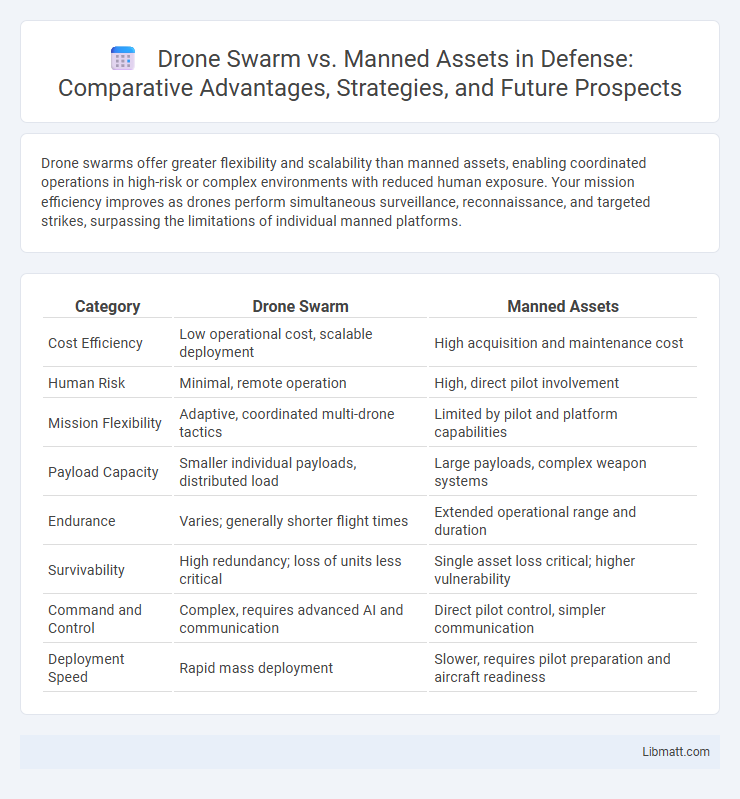Drone swarms offer greater flexibility and scalability than manned assets, enabling coordinated operations in high-risk or complex environments with reduced human exposure. Your mission efficiency improves as drones perform simultaneous surveillance, reconnaissance, and targeted strikes, surpassing the limitations of individual manned platforms.
Table of Comparison
| Category | Drone Swarm | Manned Assets |
|---|---|---|
| Cost Efficiency | Low operational cost, scalable deployment | High acquisition and maintenance cost |
| Human Risk | Minimal, remote operation | High, direct pilot involvement |
| Mission Flexibility | Adaptive, coordinated multi-drone tactics | Limited by pilot and platform capabilities |
| Payload Capacity | Smaller individual payloads, distributed load | Large payloads, complex weapon systems |
| Endurance | Varies; generally shorter flight times | Extended operational range and duration |
| Survivability | High redundancy; loss of units less critical | Single asset loss critical; higher vulnerability |
| Command and Control | Complex, requires advanced AI and communication | Direct pilot control, simpler communication |
| Deployment Speed | Rapid mass deployment | Slower, requires pilot preparation and aircraft readiness |
Introduction to Drone Swarms and Manned Assets
Drone swarms consist of multiple autonomous or semi-autonomous unmanned aerial vehicles (UAVs) working collaboratively to perform complex missions, offering advantages in scalability, redundancy, and cost-efficiency compared to manned assets. Manned assets include traditional aircraft piloted by humans, providing direct human control, advanced decision-making capabilities, and adaptability in dynamic environments. The integration of drone swarms and manned platforms enables enhanced operational flexibility, improved situational awareness, and increased mission success rates in defense and commercial applications.
Evolution of Drone Swarm Technology
Drone swarm technology has rapidly evolved from basic coordination algorithms to advanced AI-driven systems capable of autonomous decision-making and adaptive mission execution. Modern swarms utilize decentralized communication networks and machine learning to enhance scalability, resilience, and effectiveness in complex environments. These advancements enable drone swarms to perform reconnaissance, target acquisition, and electronic warfare with greater efficiency compared to traditional manned assets.
Advantages of Drone Swarms in Modern Warfare
Drone swarms offer unparalleled operational flexibility and scalability in modern warfare, enabling simultaneous multi-target engagement and persistent surveillance that manned assets struggle to match. Their autonomous coordination reduces pilot risk and operational costs while providing rapid adaptability to dynamic combat environments. You can leverage drone swarms for increased battlefield coverage and enhanced situational awareness, giving strategic advantages over traditional manned systems.
Strengths of Manned Assets in Combat Scenarios
Manned assets offer superior situational awareness and decision-making capabilities driven by human intuition and experience, critical in complex combat environments. They provide robust communication and coordination, enabling dynamic responses to evolving threats and mission objectives. The inherent ability of pilots to manage unforeseen technical failures and make ethical judgments enhances operational reliability and mission effectiveness.
Cost-Efficiency: Drone Swarms vs Manned Systems
Drone swarms offer significant cost-efficiency compared to manned systems due to lower acquisition, maintenance, and operational expenses. Unlike manned assets, drones require no pilot training or life-support systems, reducing overall investment and risk. Your defense or commercial operations can achieve scalable, flexible deployment with drone swarms while minimizing financial burden.
Tactical Flexibility and Deployment Speed
Drone swarms offer unparalleled tactical flexibility through rapid reconfiguration and adaptive mission profiles that manned assets struggle to match due to pilot limitations and mechanical constraints. Their deployment speed is significantly faster, enabling immediate response and real-time coordination across multiple drones for complex operations. Your tactical edge increases dramatically when integrating drone swarms, as they provide scalable firepower and persistent surveillance without risking human pilots.
Vulnerabilities and Countermeasures
Drone swarms face vulnerabilities such as GPS jamming, signal interception, and limited onboard processing power, which can disrupt coordination and navigation. Countermeasures include employing frequency hopping, encrypted communication links, and autonomous decision-making algorithms to enhance resilience. Manned assets are susceptible to pilot fatigue and limited situational awareness but benefit from advanced electronic warfare systems and adaptive tactics to counter drone threats.
Human Decision-Making vs Autonomous Operations
Drone swarms leverage autonomous operations powered by artificial intelligence, enabling rapid, coordinated responses beyond human reaction speeds. Manned assets rely on human decision-making, providing adaptable judgment and ethical considerations in complex, unpredictable environments. Your strategic choice depends on balancing the speed and scalability of drone swarms with the nuanced oversight delivered by human pilots.
Future Trends in Integrated Combat Forces
Drone swarm technology is rapidly advancing, offering scalable, cost-effective, and highly coordinated offensive and defensive capabilities that complement manned assets in integrated combat forces. Future trends emphasize seamless communication networks and AI-driven autonomy to enhance situational awareness, reduce human risk, and enable complex mission execution with manned-unmanned teaming. Integration of drone swarms with manned platforms is set to transform battlefield dynamics by increasing operational flexibility, persistence, and force multiplication.
Conclusion: Selecting the Optimal Force Structure
Selecting the optimal force structure between drone swarms and manned assets depends on mission requirements, risk tolerance, and operational environment. Drone swarms excel in scalability, endurance, and cost-effectiveness for surveillance and saturation attack scenarios, while manned assets provide human judgment, adaptability, and complex decision-making critical in unpredictable or high-stakes engagements. Integrating both platforms enhances force versatility, leveraging unmanned systems for force multiplication and manned units for command and control in modern military operations.
drone swarm vs manned assets Infographic

 libmatt.com
libmatt.com